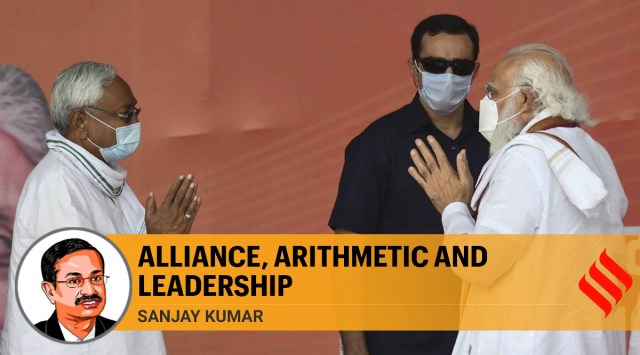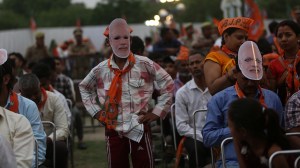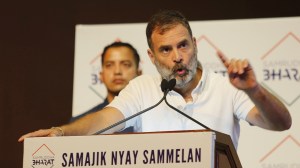- India
- International
NDA has a slight edge in Bihar polls, despite Nitish Kumar’s dwindling popularity
The going for NDA in 2020 could have been tougher than it looks like at the moment, had the opposition parties been able to form a united alliance against Nitish Kumar, led by a popular leader. But the opposition is fragmented. And this could result in a split in the anti-NDA votes.
 Prime Minster Narendra Modi, right, greets Bihar Chief Minister Nitish Kumar, left during a campaign ahead of Bihar state Assembly elections. in Patna, Wednesday. (AP)
Prime Minster Narendra Modi, right, greets Bihar Chief Minister Nitish Kumar, left during a campaign ahead of Bihar state Assembly elections. in Patna, Wednesday. (AP)The inability of any one political party to win a majority on its own makes alliance formation crucial for winning an election in Bihar. This has been the story of the last seven assembly elections and continues to be the story now. Neither of the two national parties, the Congress and BJP, nor the two dominant regional parties, the JD(U) and RJD, are in a position to win a majority on their own. Smaller regional parties like the Lok Jan Shakti Party (LJP), Hindustan Awam Morcha (HAM) of Jitan Ram Manjhi, Rashtriya Lok Samata Party (RLSP) of Upendra Kushwaha or Vikassheel Insaan Party (VIP) of Mukesh Sahani enjoy limited support. Nitish Kumar is a popular chief minister but his capacity to win votes for his party remains limited, given its presence in only a few districts. Even at his peak, Lalu Prasad was unable to win a majority on his own. This political plurality makes alliance key to the electoral success. Any alliance which has two of the three major parties — the JD(U), BJP and RJD — enjoys a definitive lead over its rivals. The verdict of various elections in Bihar over the last few decades has never defied this trend.
The inability of any party to win a majority on its own could be explained by its support base, which remains limited. The JD(U) and RJD are popular mainly amongst castes in the OBC category — Kurmis and Yadavs, respectively. The other two regional parties, LJP and HAM, attract the Dalit vote. The RLSP enjoys support amongst one dominant OBC caste, the Koeris, while Pappu Yadav’s Jan Adhikar Party is eyeing young Yadav voters besides trying to attract voters from other caste communities. Keeping in mind the sizeable number of Muslim voters in Bihar, the AIMIM has made an entry in Bihar elections in recent times.
Post-Mandal politics has inculcated a strong sense of party loyalty amongst supporters of regional parties, shaped largely by their caste identity. The sectional support base of parties, their inability to move beyond their core support base to attract new voters, has forced parties to form pre-poll alliances aimed at transferring the votes of their core supporters to each other for maximising electoral gains. The upper castes had been the core supporters of the BJP, and two upper-backward castes, Kurmis and Koeris, have been core supporters of the JD(U). The alliance of the two along with other parties has helped consolidate the votes of these castes for the NDA.
Similarly, Yadavs and Muslims have been the core supporters of the RJD and the Congress still manages to get some votes amongst various castes. Muslims and various lower OBC castes have voted for the Congress in some constituencies. The alliance of the RJD and Congress would consolidate the Muslim and Yadav vote. The joining of three Left parties with the RJD-Congress alliance would help further consolidation of votes in favour of the Mahagathbandan.

The question is: Which formation is ahead in the electoral race?
Going by the aforementioned information, the NDA seems to be ahead at the moment. What makes the NDA’s position slightly stronger is the sub-alliance the JD(U) has managed to form with HAM and the BJP with the VIP. This alliance should consolidate the upper castes, Kurmis, sections of lower OBC votes, especially from the Mallah caste and non-Dushad Dalit votes. This social coalition should result in electoral arithmetic conducive for the NDA to win these elections. Electoral arithmetic normally pays dividends, but not always. Recall what happened in UP during the 2019 Lok Sabha election — even as allies, the SP-BSP could not prevent the BJP from registering a big victory in UP.
This may not worry the NDA too much, but what may be a cause of concern for the NDA is the declining popularity of Nitish Kumar, though he remains more popular than any other leader from the opposition parties. The youth seems to be unhappy due to growing unemployment in the state and large numbers of them blame Nitish Kumar for this. While the employment scenario was not good before lockdown, it has certainly made the situation even worse. Add to this 15 years of anti-incumbency and people’s dissatisfaction with the sitting MLA. The decision of Chirag Paswan to contest elections against JD(U) candidates with the sole aim of defeating JD(U) should also be a matter of concern for the Nitish camp.
Going by this picture, the going for NDA in 2020 could have been tougher than it looks like at the moment, had the opposition parties been able to form a united alliance against Nitish Kumar, led by a popular leader. But the opposition is fragmented. And this could result in a split in the anti-NDA votes.
Not only was the Mahagathbandan unable to retain its 2015 ally, the JD(U), for long, but even smaller regional parties like HAM, RLSP and VIP which were part of Mahagathbandan during the 2019 Lok Sabha elections have also deserted it. Some were unhappy with the seat-sharing arrangement while others had issues with the leadership of the alliance. Such a situation within the opposition camp will hardly enthuse even those voters who may have thought of switching from the NDA to Mahagathbandan. All in all, the NDA seems to have an edge at the moment.
This article first appeared in the print edition on October 29, 2020 under the title “Alliance, arithmetic and leadership”. The writer is professor at Centre for the Study of Developing Societies, Delhi and a political analyst. Views are personal
Opinion | Dipankar Bhattacharya writes: In Bihar, BJP is trying to spread fear about CPI(ML). It won’t work
EXPRESS OPINION
Apr 24: Latest News
- 01
- 02
- 03
- 04
- 05










































